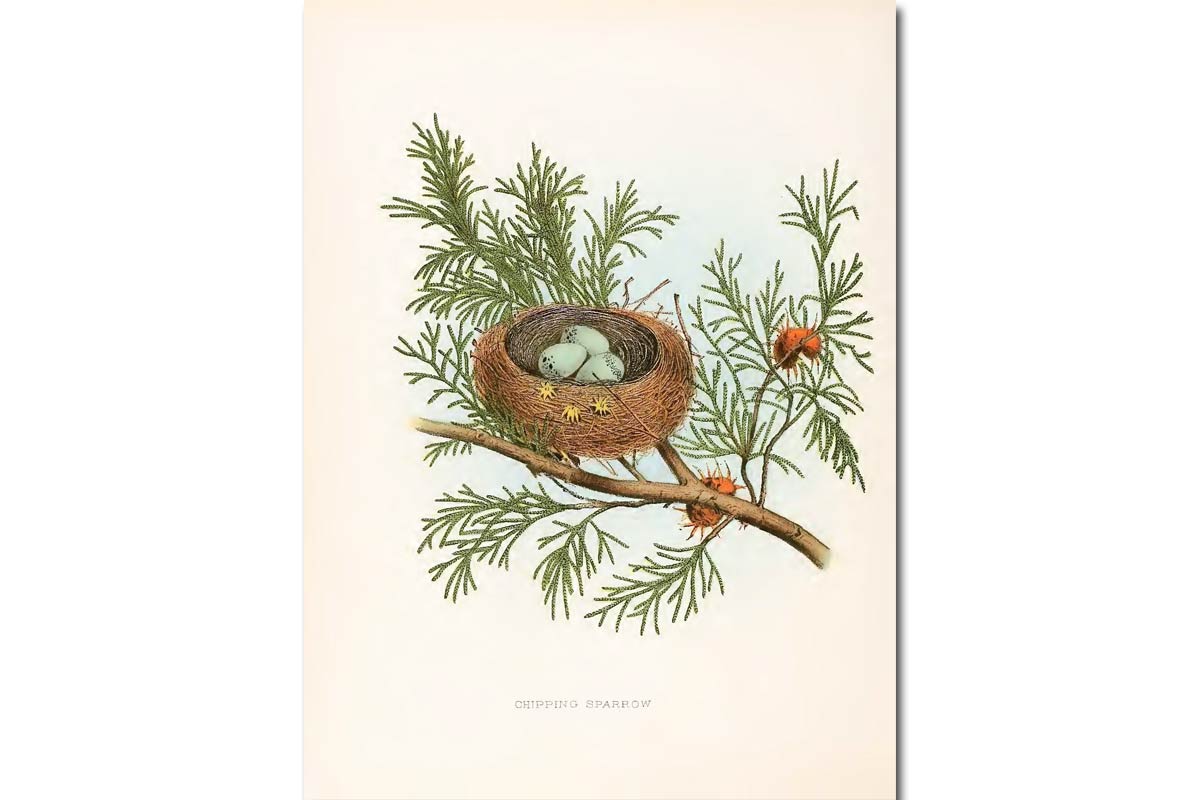
Plate 12: Chipping Sparrow
Unusually dainty nest; you’ll enjoy the chipping sparrow’s monotonous chipping song as a pleasant part of spring.
Spizella passerina
Chipping Sparrows are not only the friendliest, but one of the best-known American sparrows. The reason is apparent, for yards, gardens and parks furnish ideal habitat for these birds. They often nest in vines or bushes just outside your window. Nesting materials include grasses, rootlets and hairs, horsehair being used extensively, when available. Their fondness for a horsehair lining in the nest sometimes leads to casualties when either parents or young become entangled.
Chippies derive their name from their songs, a series of chip notes which they utter. This is a rapid, unmusical series of notes, all on the same pitch. They frequently join the Robins to start the day with song. Juncos and some of the warblers also use a series of chip notes in their songs, but with more variations and more musical in quality.
They feed heavily on insects and larvae, including various caterpillars, beetles, ants and plant lice. Vegetable food amounts to a little more than half their diet and includes seeds from grasses and weeds. Crab grass seeds seem to be a favorite.
Western Chipping Sparrows are slightly larger and paler but show the rusty cap, black beak and other markings which are distinctive.
Introduction to Our Bird Friends, Vol II
Suggestions
- Print out the notebooking pages provided below.
- Read the Chipping Sparrow story in Bird Biographies out loud.
- Have a younger student orally narrate what was read. He can then copy a few lines of his narration onto the notebooking pages.
- Older students can read the text, Plate XII: Chipping Sparrow, and provide a written narration.
- Sketch the bird. This encourages attention to detail, which will aid in identifying the bird later on. Another option is to use the printables provided below.
- Sketch the nest of the bird, along with the eggs. Note where the nest is usually found.
- Older students can include the taxonomy.
- Learn more about the Chipping Sparrow at Cornell.
- On one notebooking page note the facts:
- Description.
- Habitat.
- Range.
- Food.
- Nest.
- Eggs.
- Call.
- The Chipping Sparrow is covered in The Burgess Bird Book: CHAPTER IV. Chippy, Sweetvoice, and Dotty.
Additional Resources
30 Narration Ideas
At some point you might appreciate some variety.
The Bird Study sections of our free nature study series: Our Wonderful World:

- Free Nature Studies: Hunting Birds With Eyes & Camera
- Free Nature Studies: Bird Guardians (Owls)
- Free Nature Studies: Landlord to the Birds
Printables & Notebooking Pages
Chipping Sparrow Notebooking Pages
Free simple notebooking set.
Chipping Sparrow
Bird picture for notebook.
Chippy the Chipping Sparrow
Corresponding print from The Burgess Bird Book.

Fifty Favorite Birds Coloring Book
Dover Nature Coloring Book based on Fifty Birds of Town and City by Bob Hines. Includes the chipping sparrow.
Chipping Sparrow Range Map
For notebook from Cornell.
Bird Facts Notebooking Page
One option in a more graphic organizer style that is especially nice for noting the facts and range.
Enjoy the entire series:











You must be logged in to post a comment.